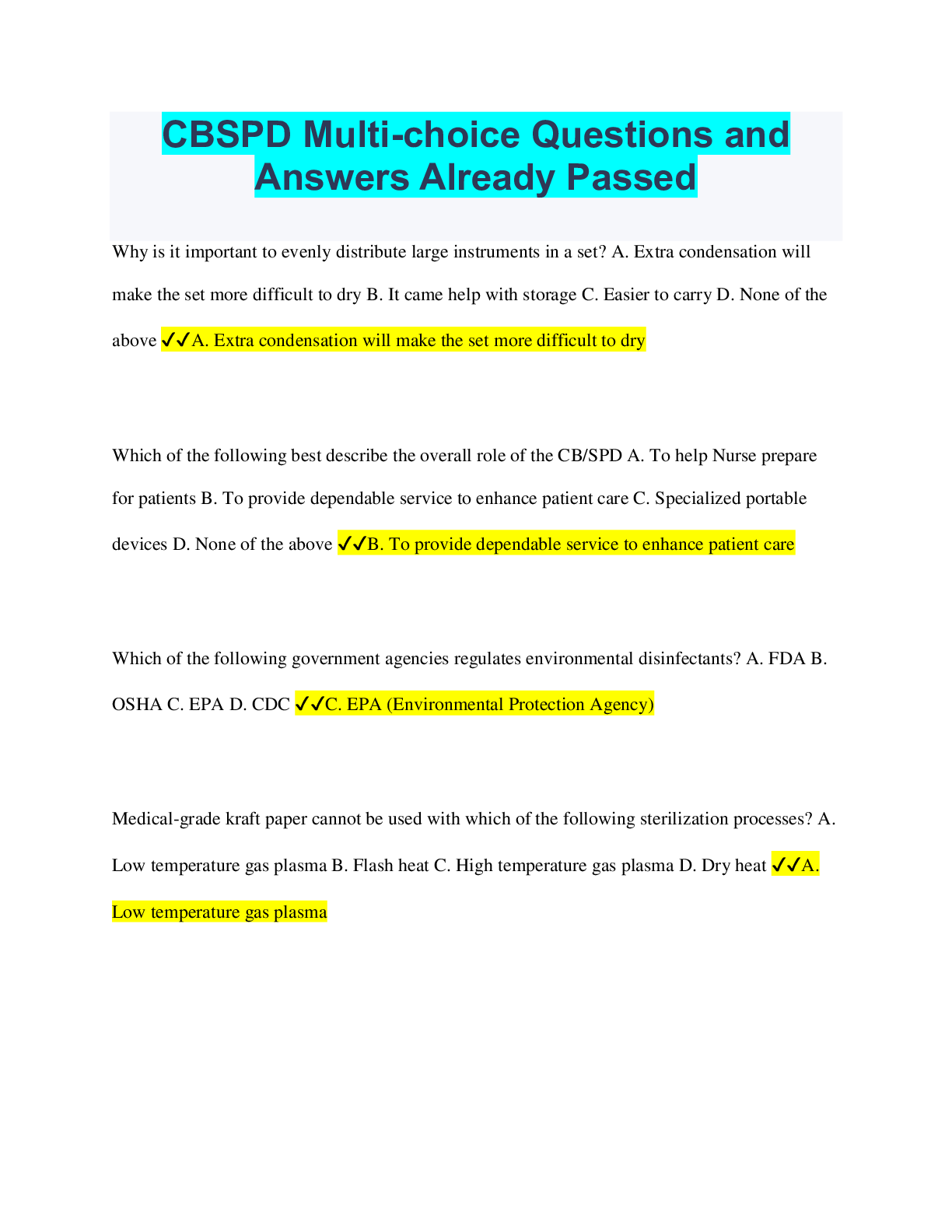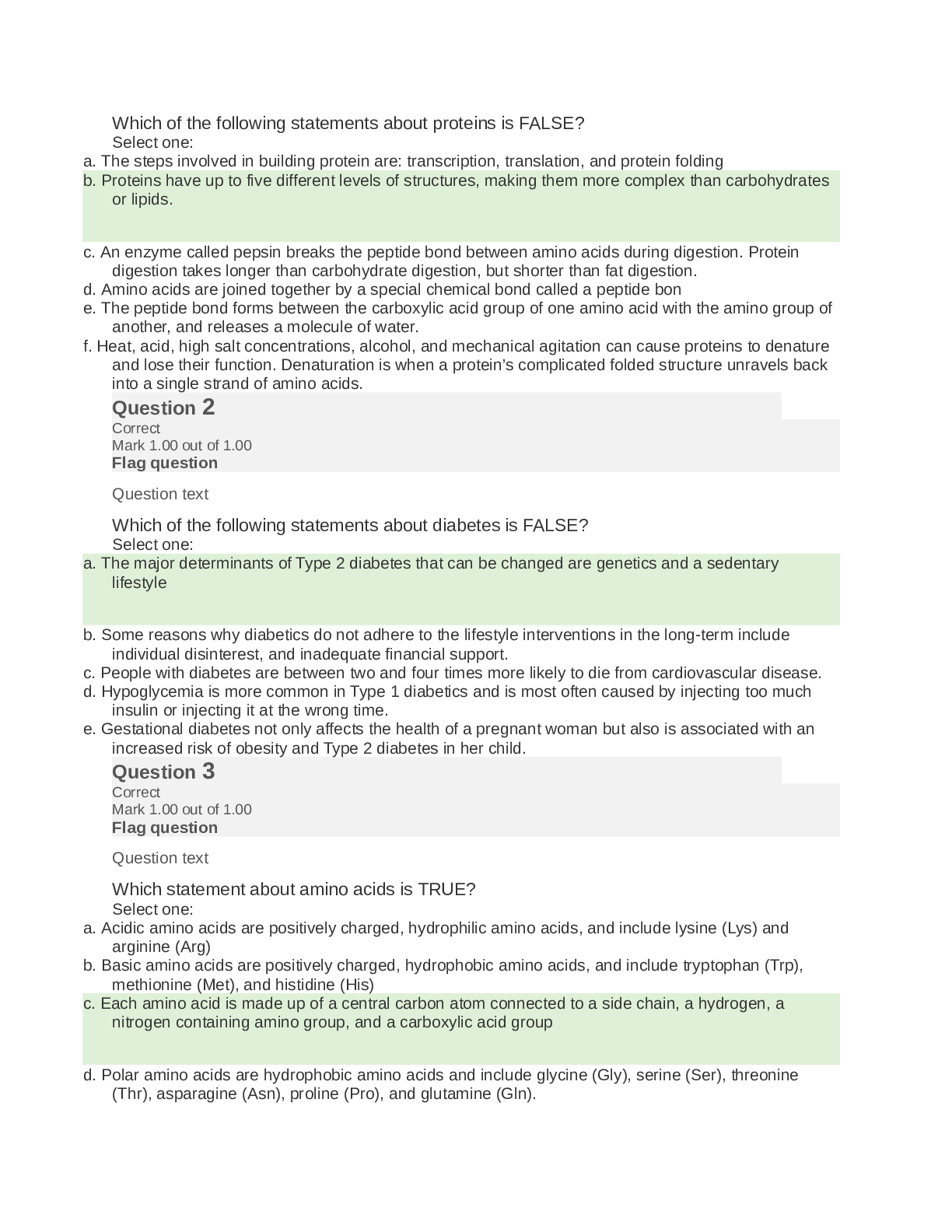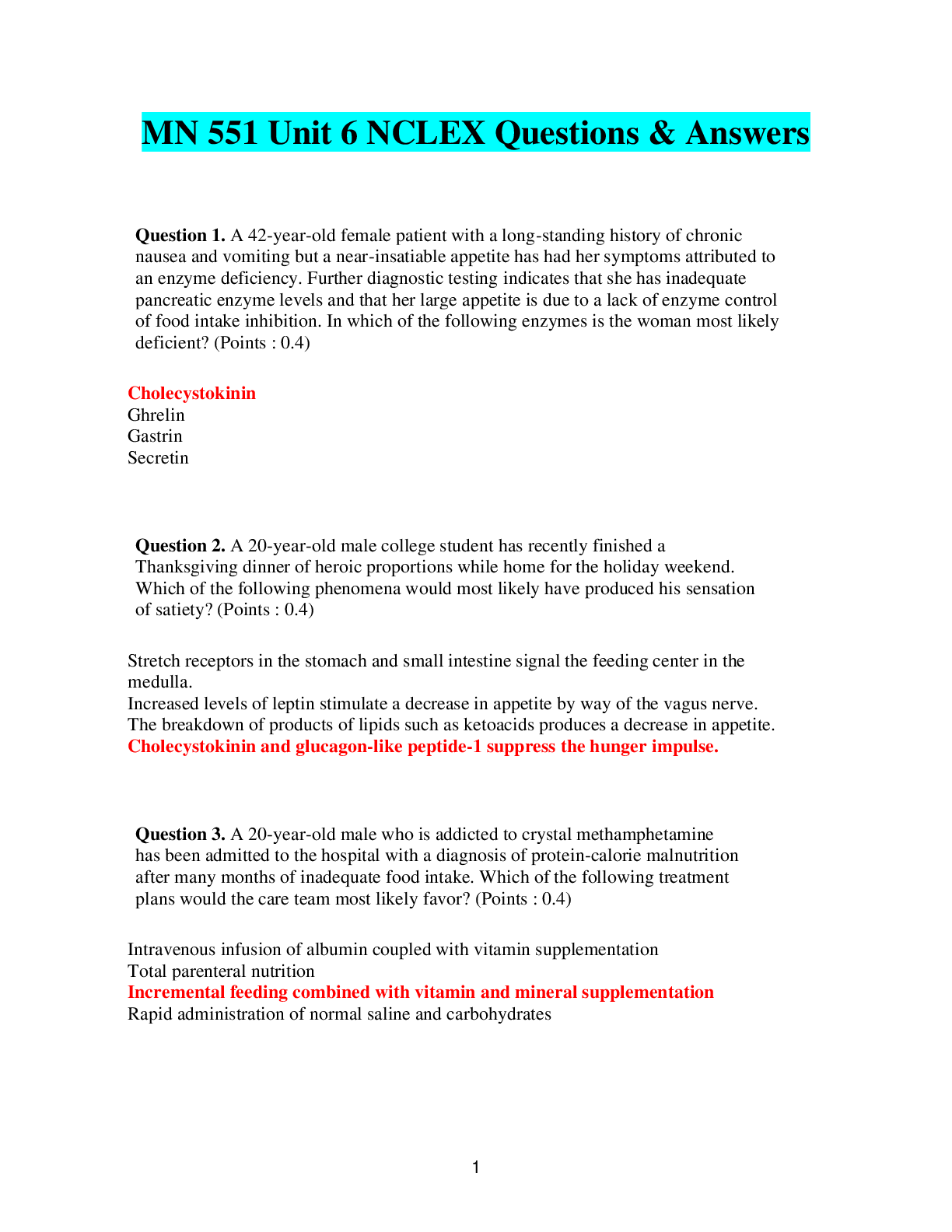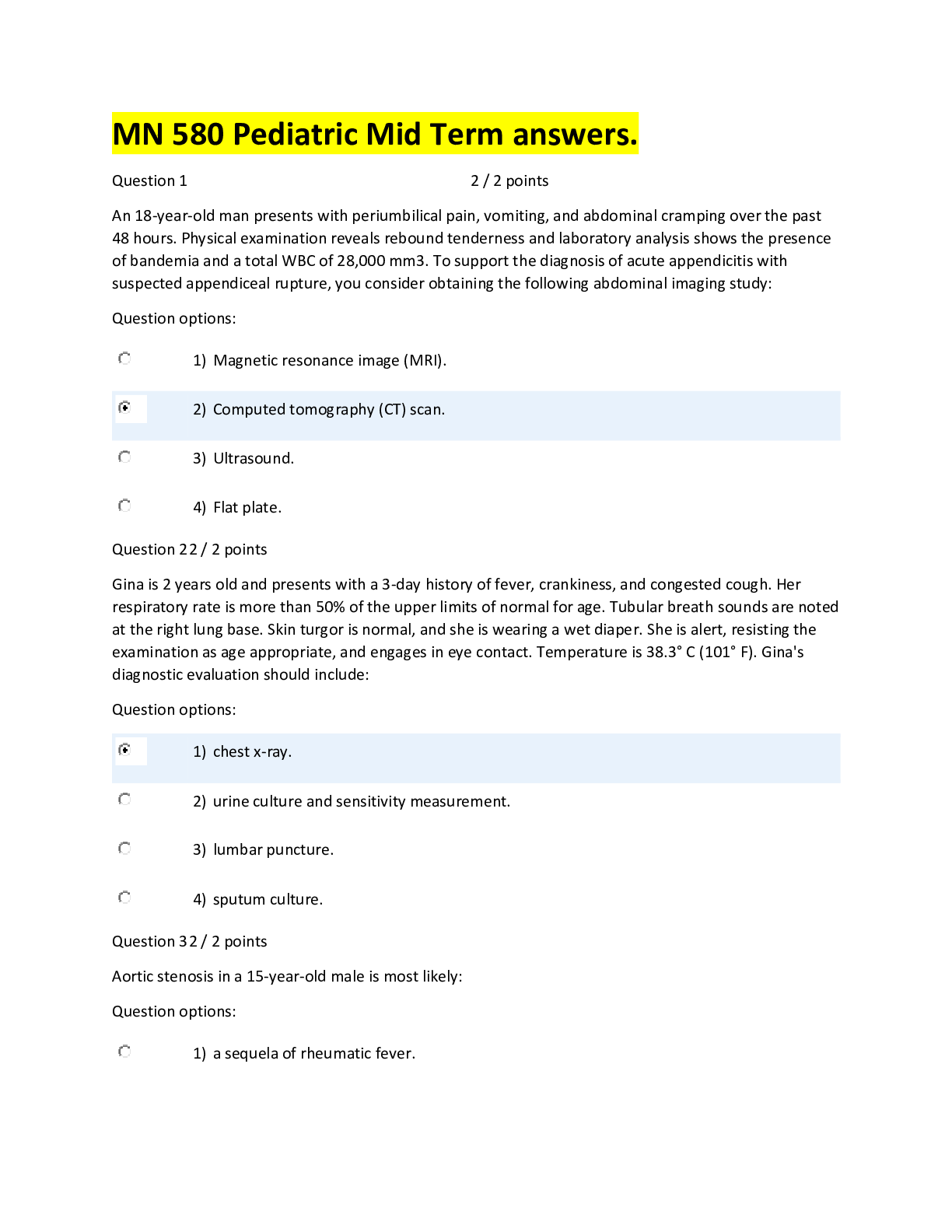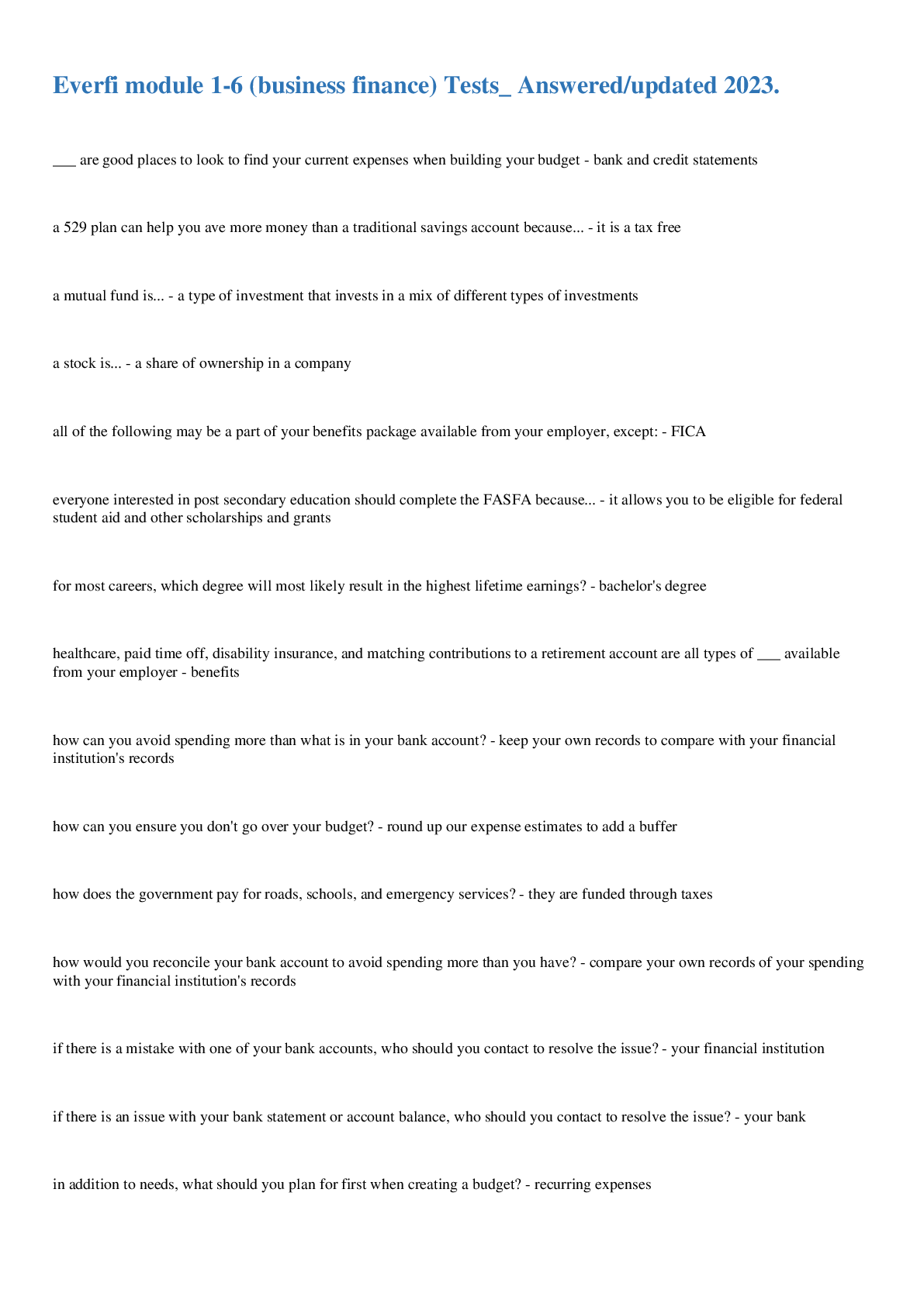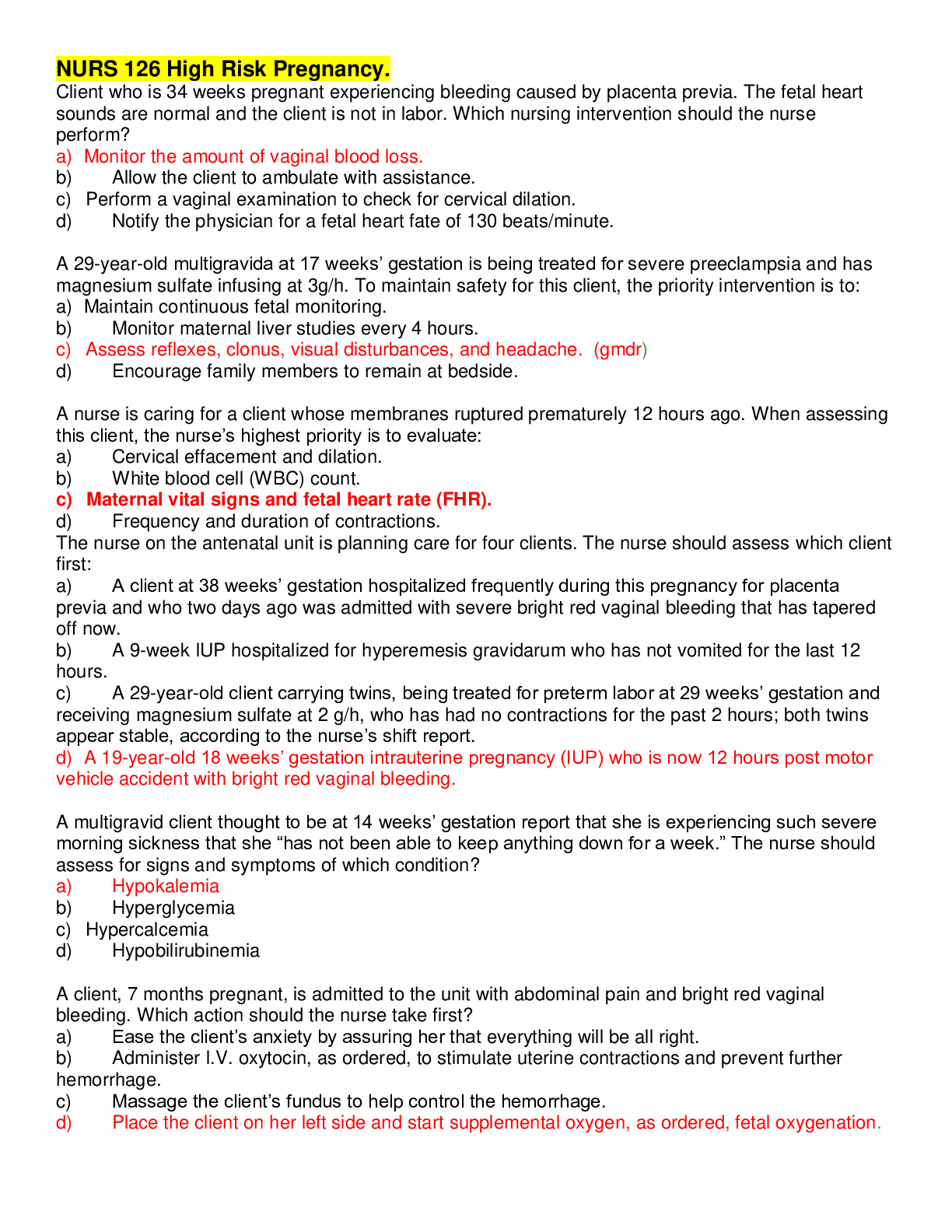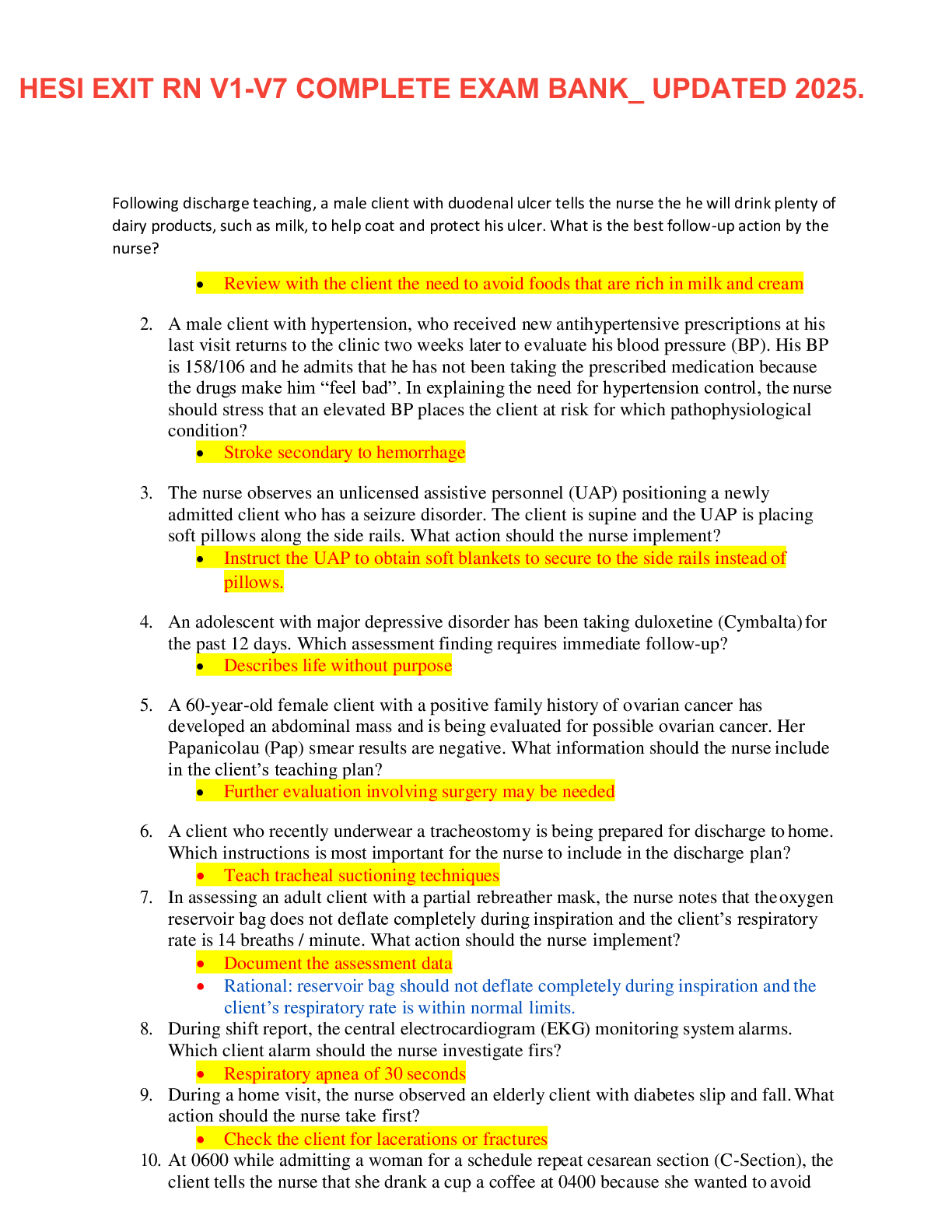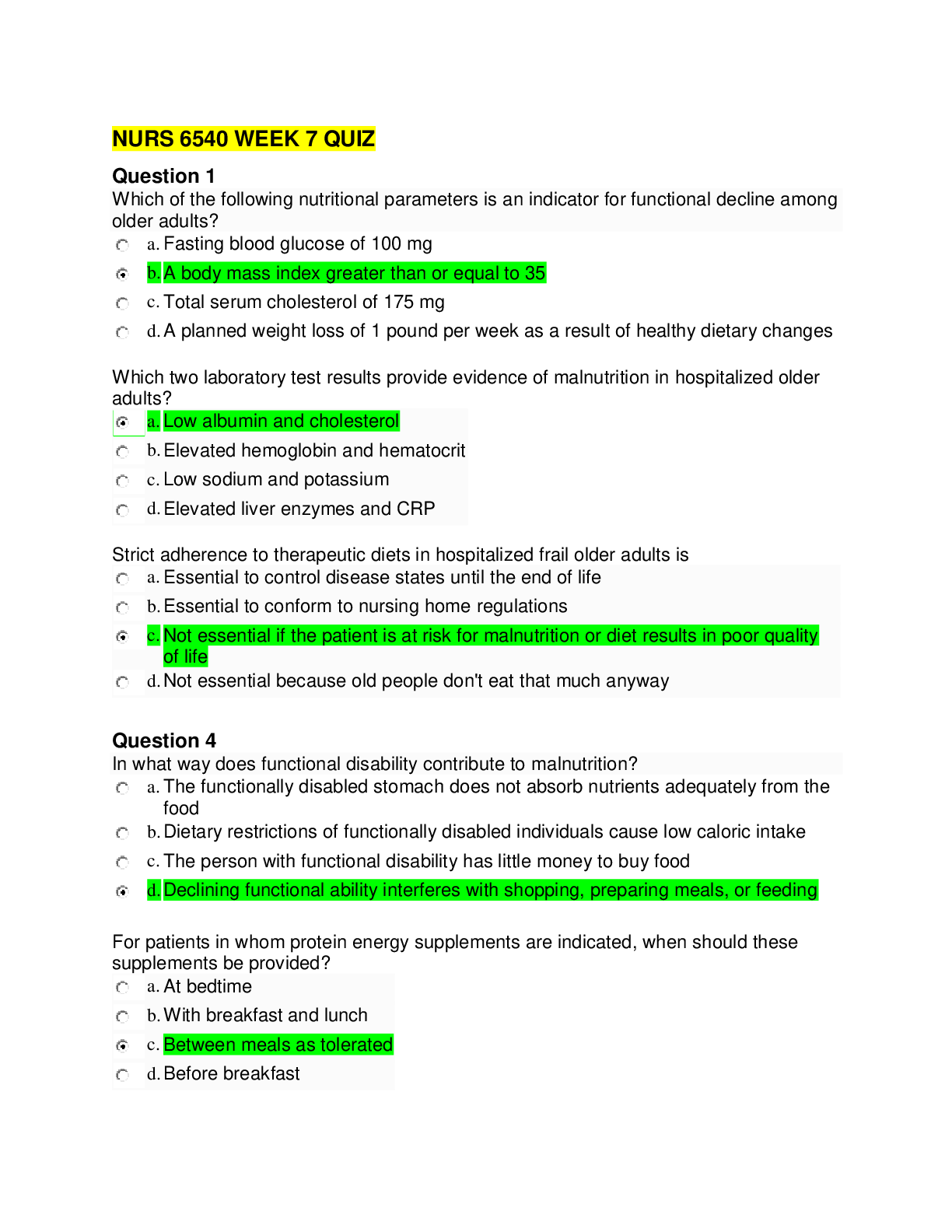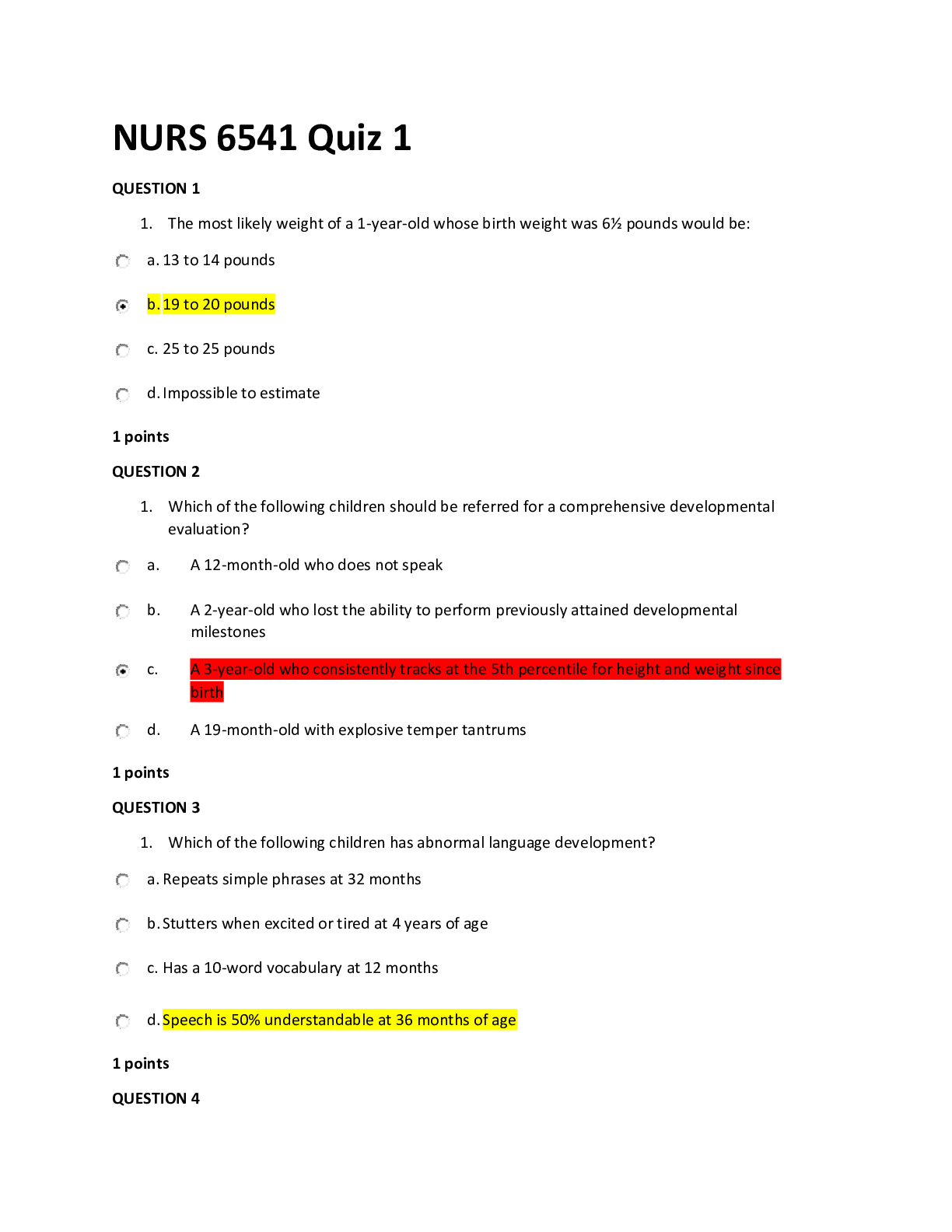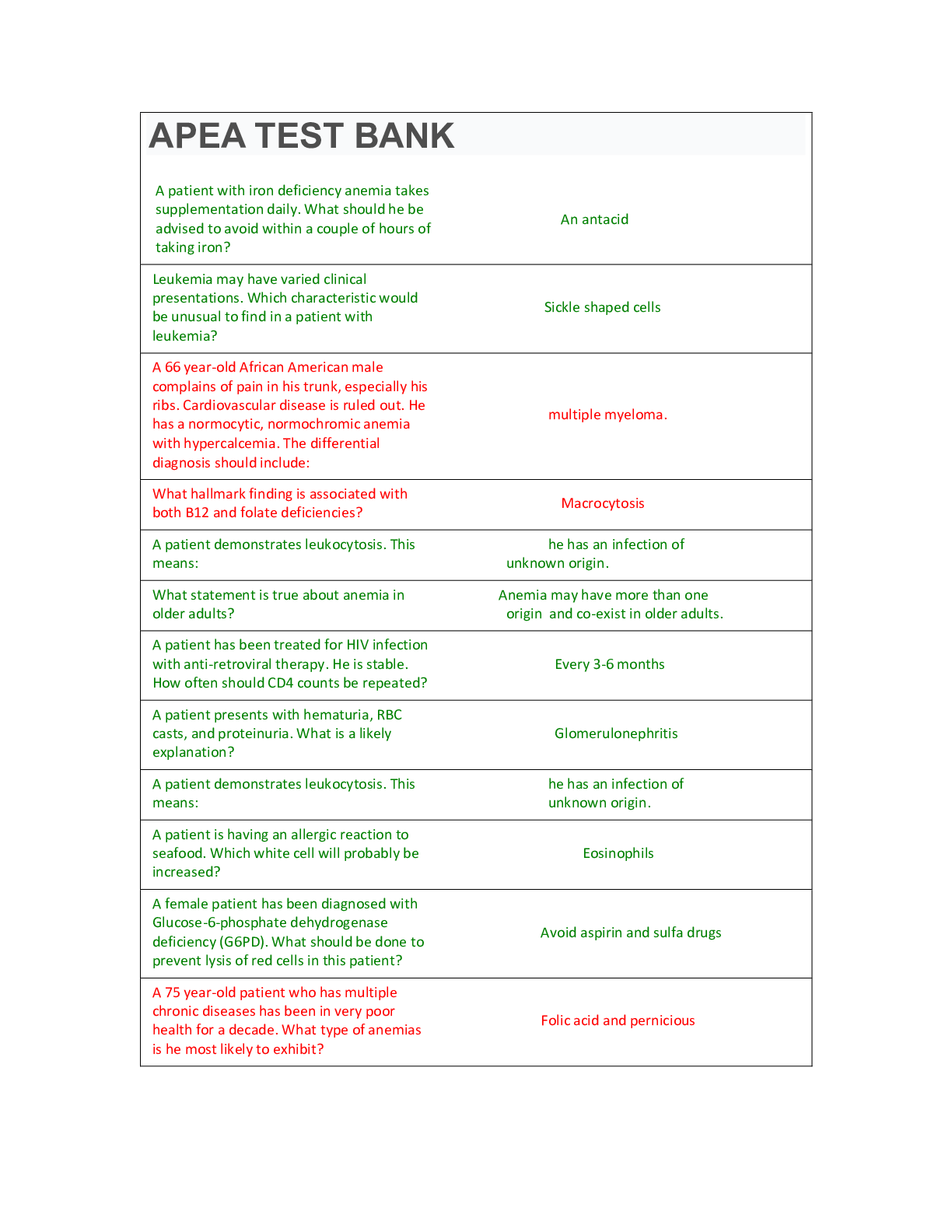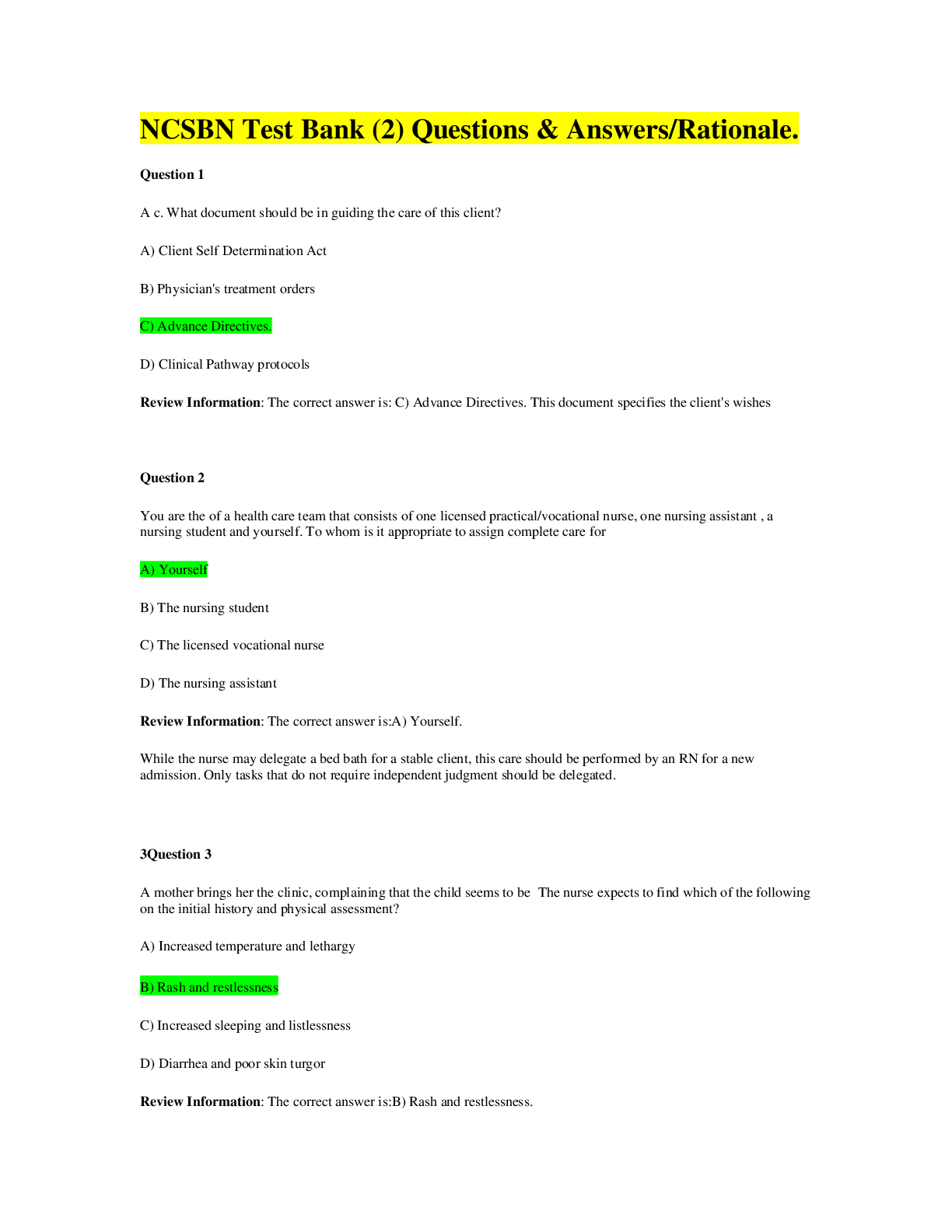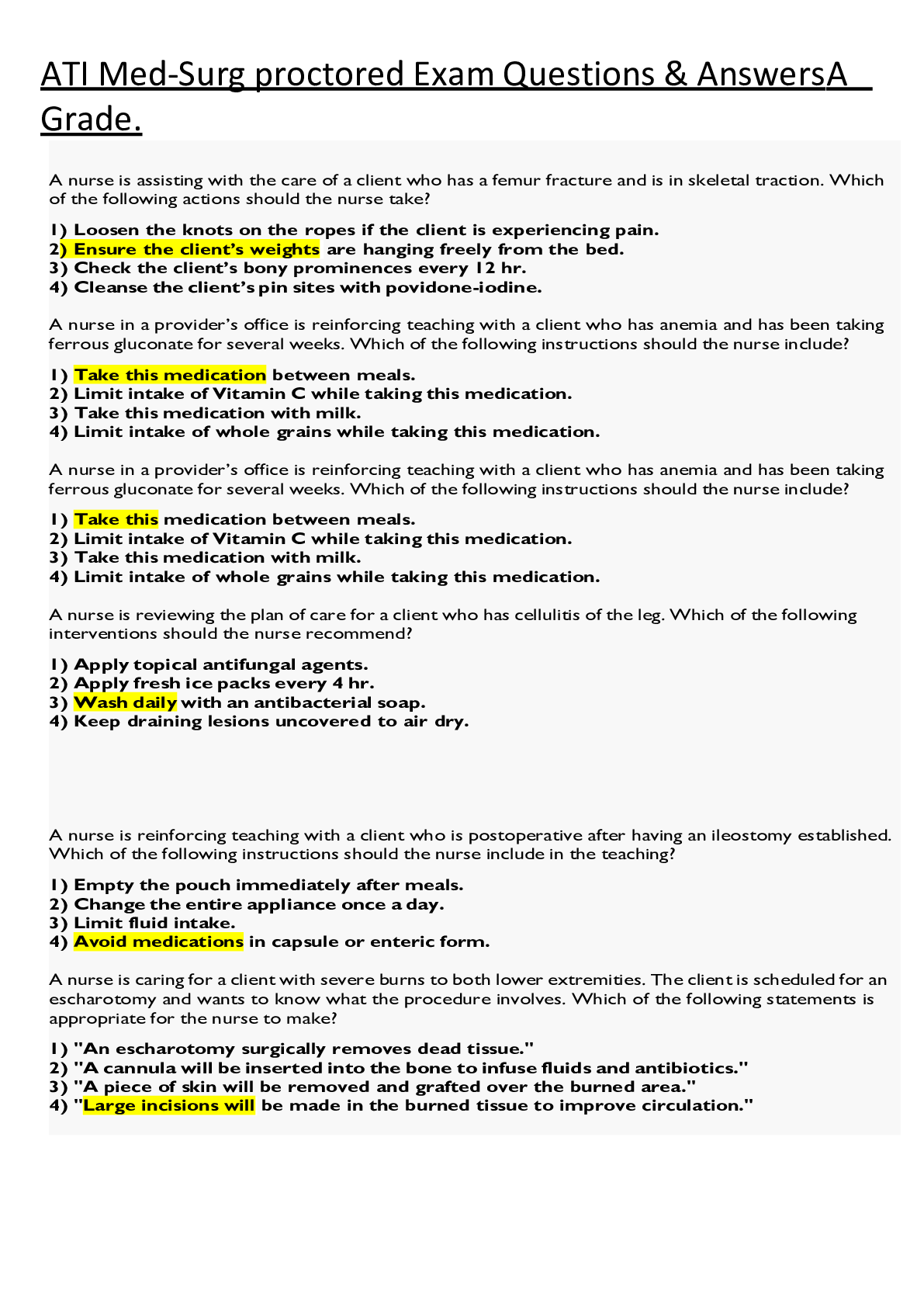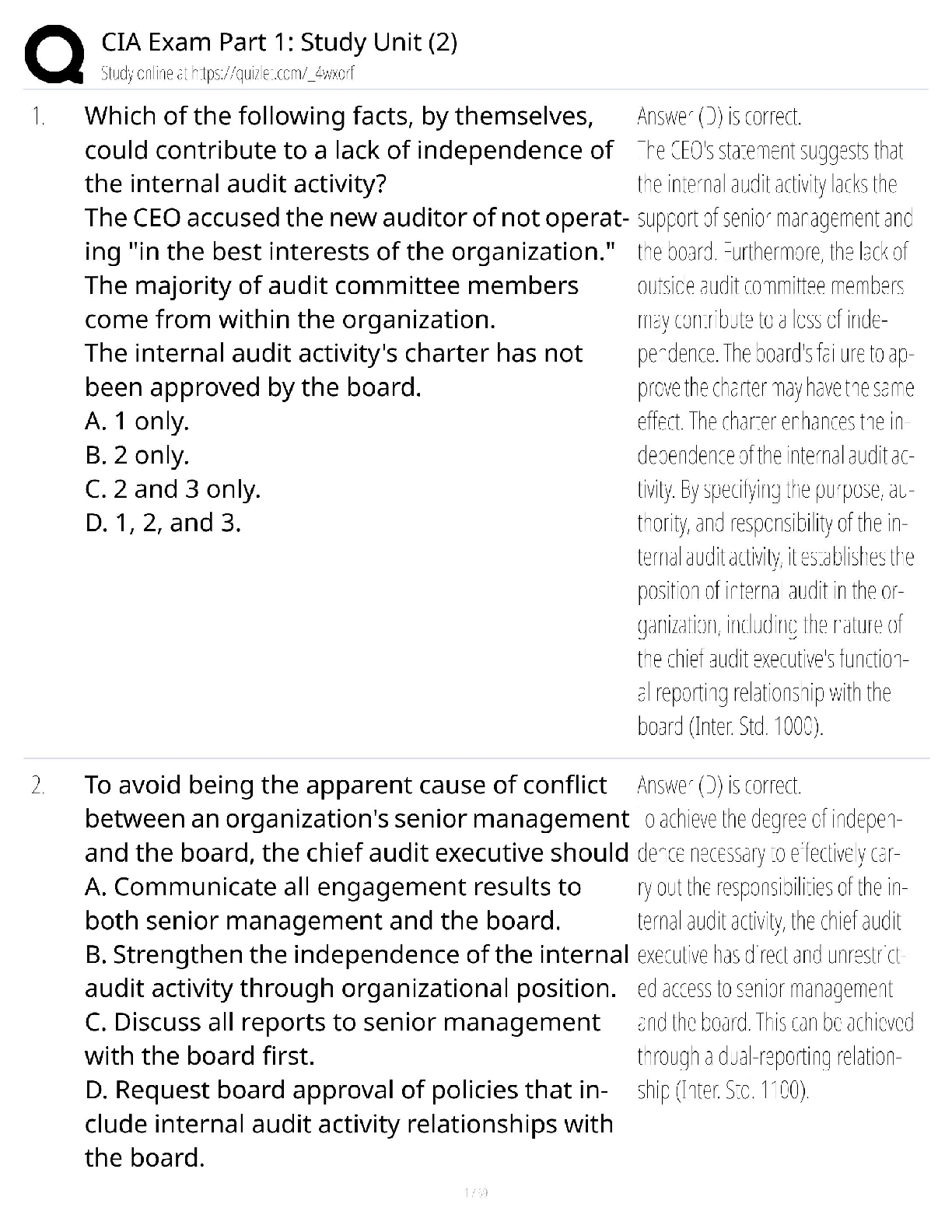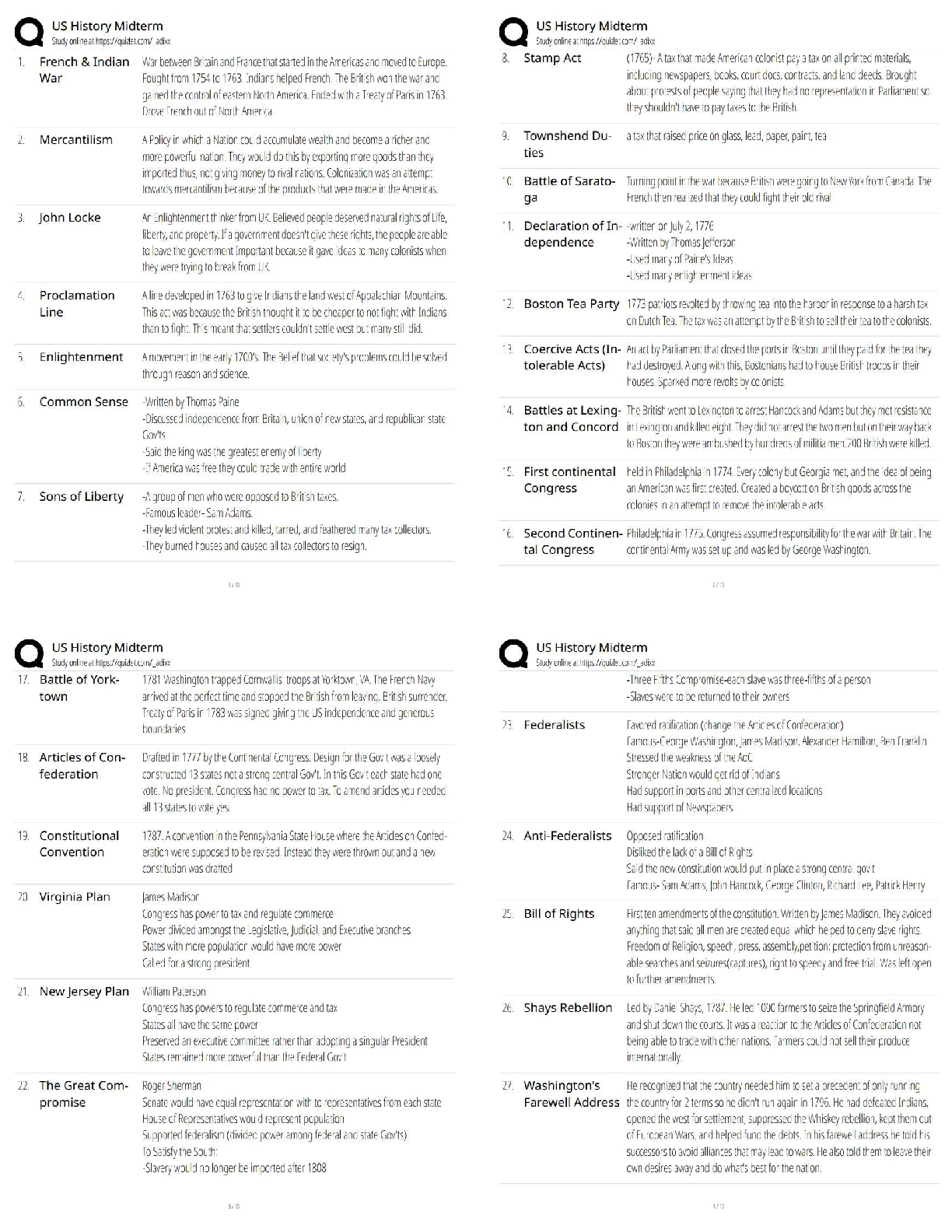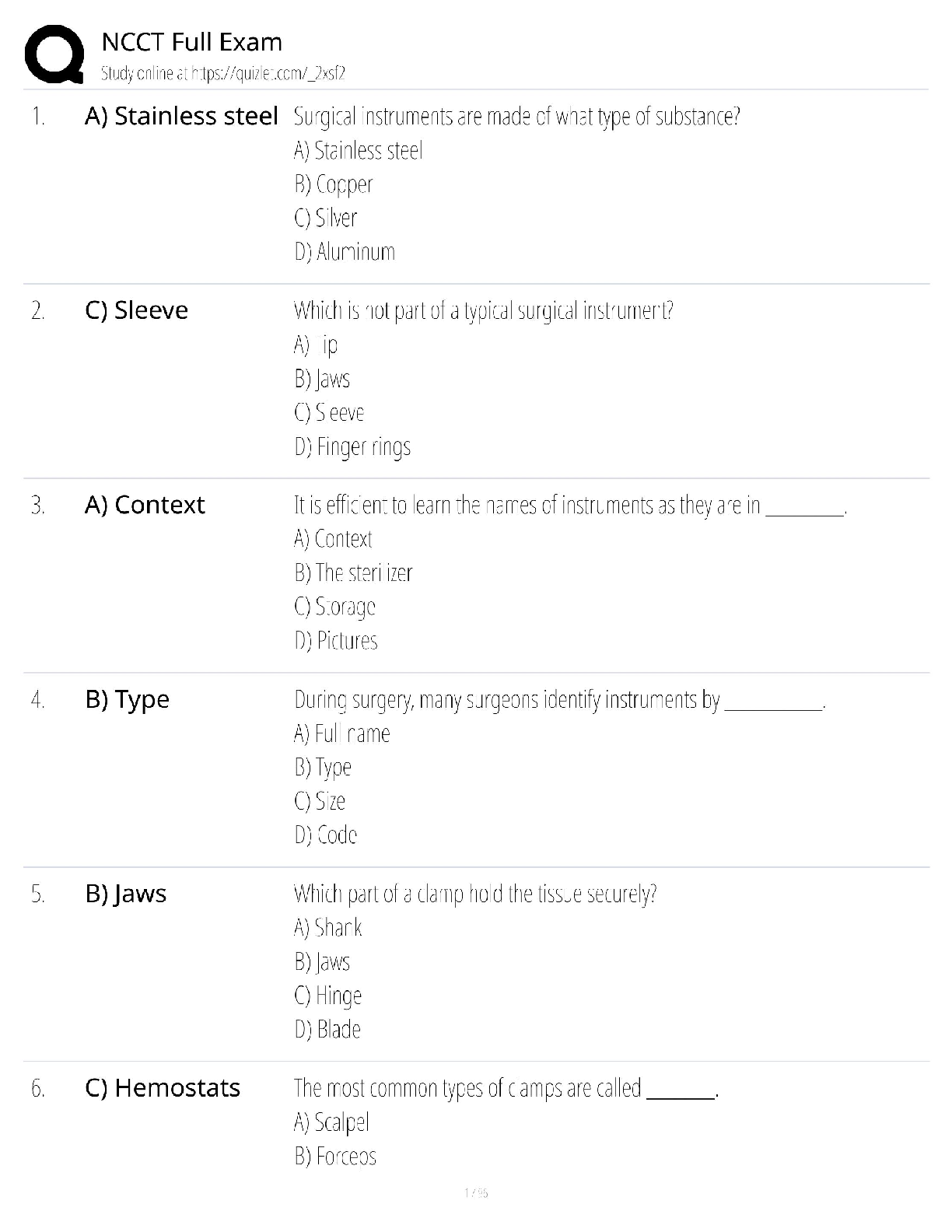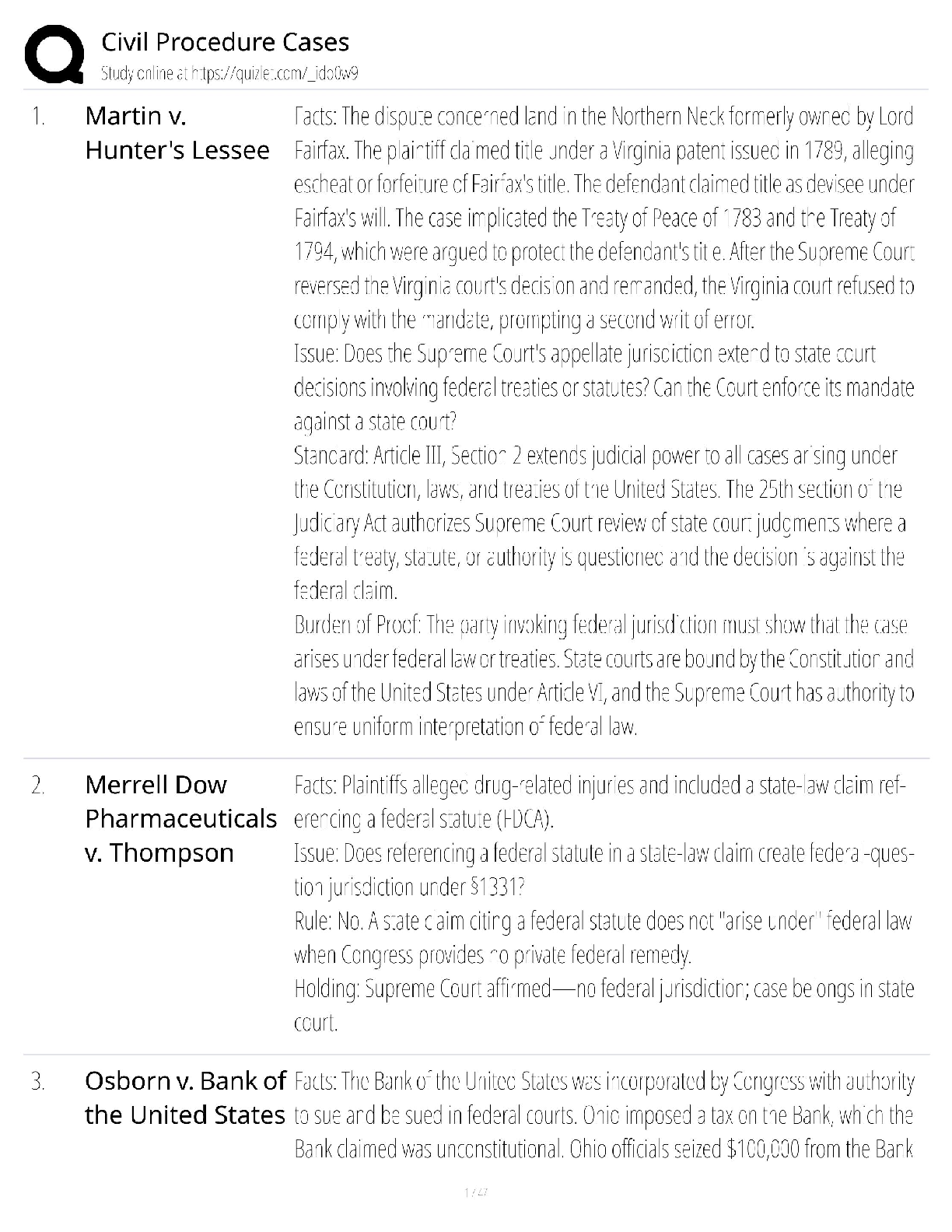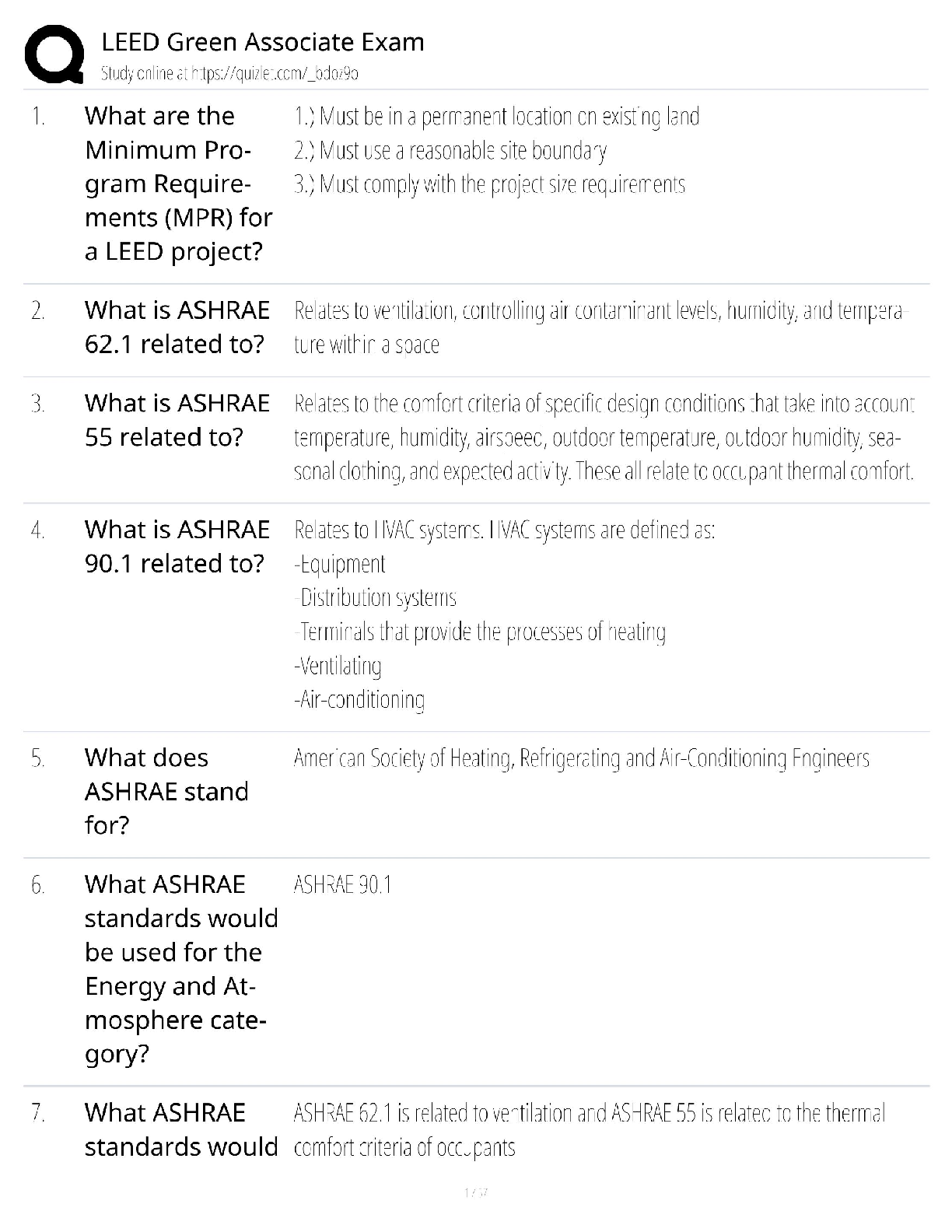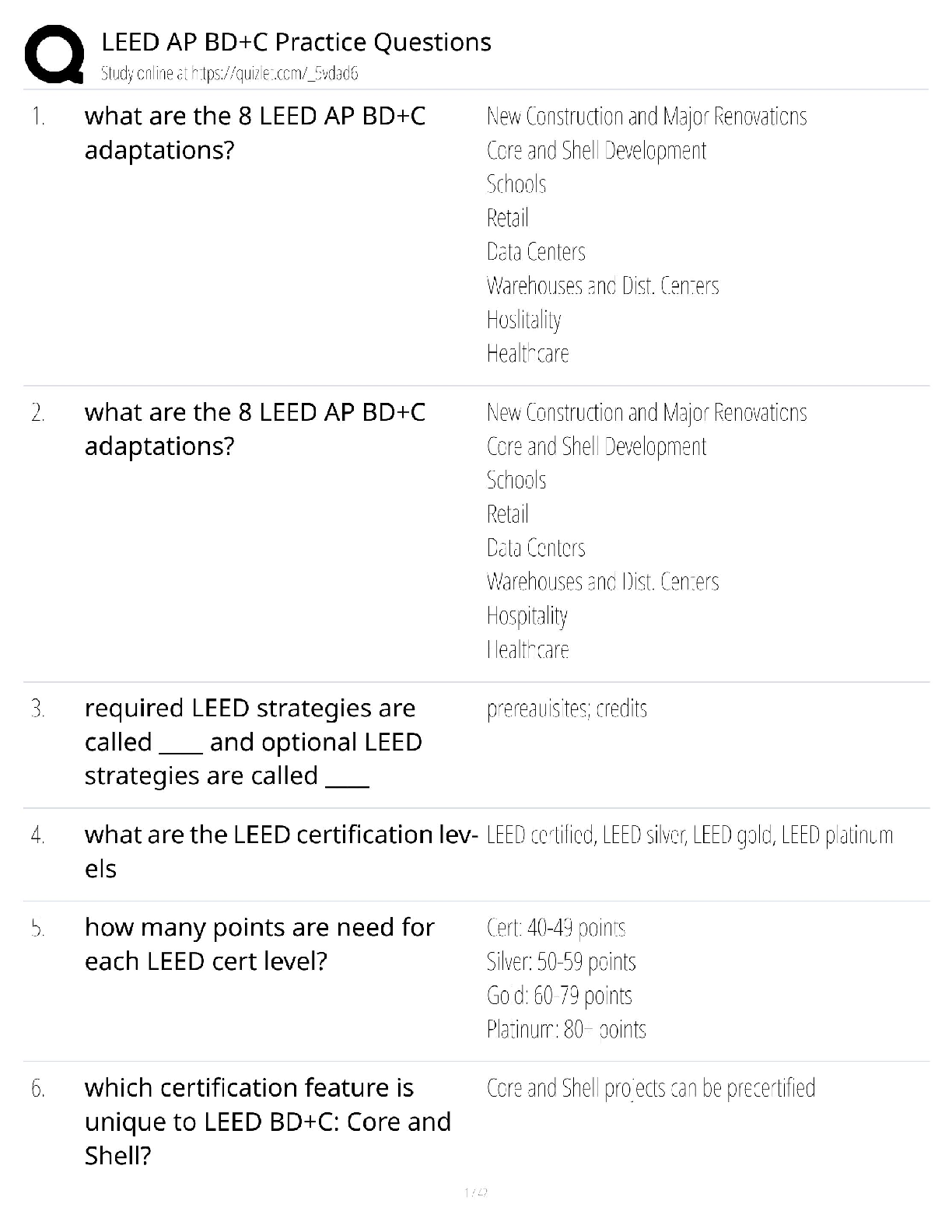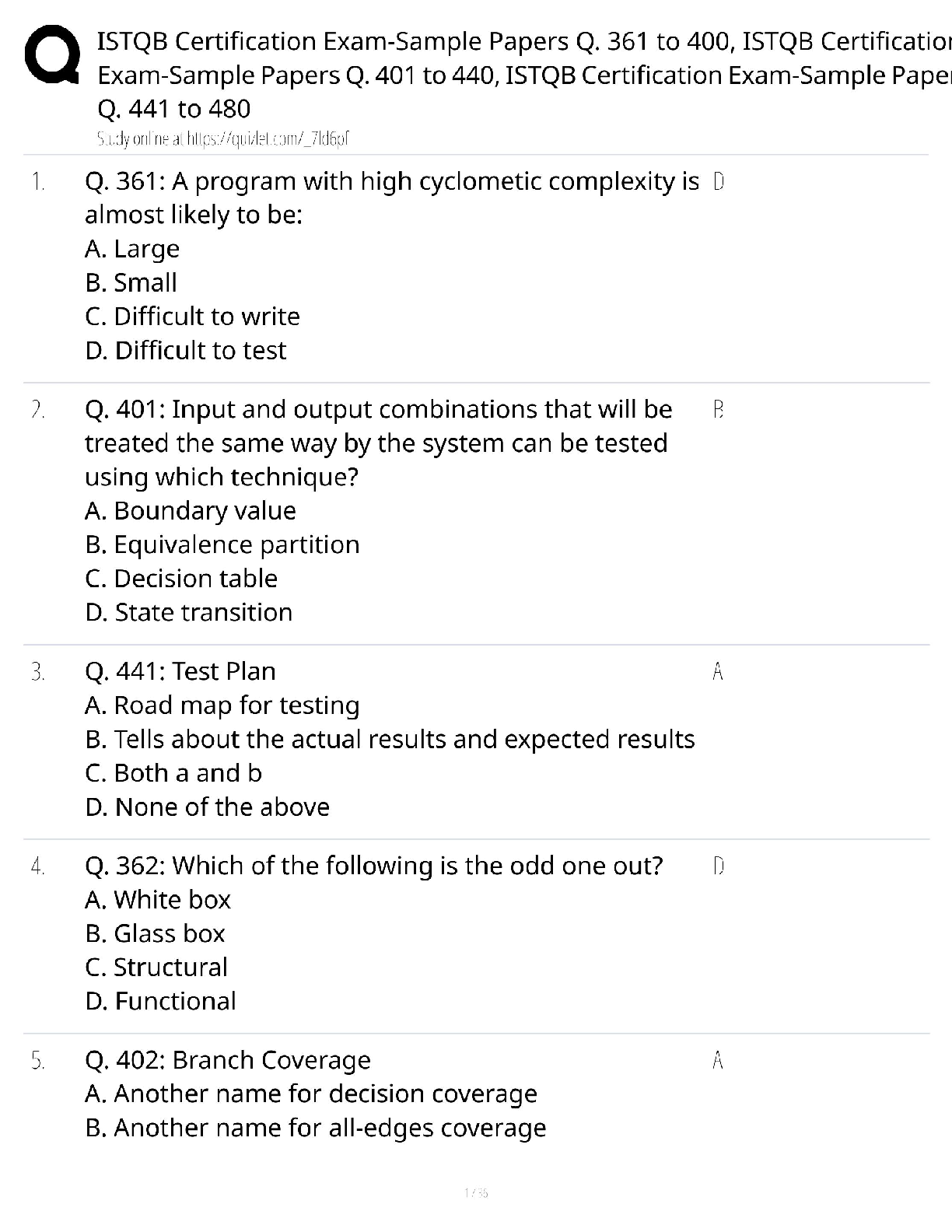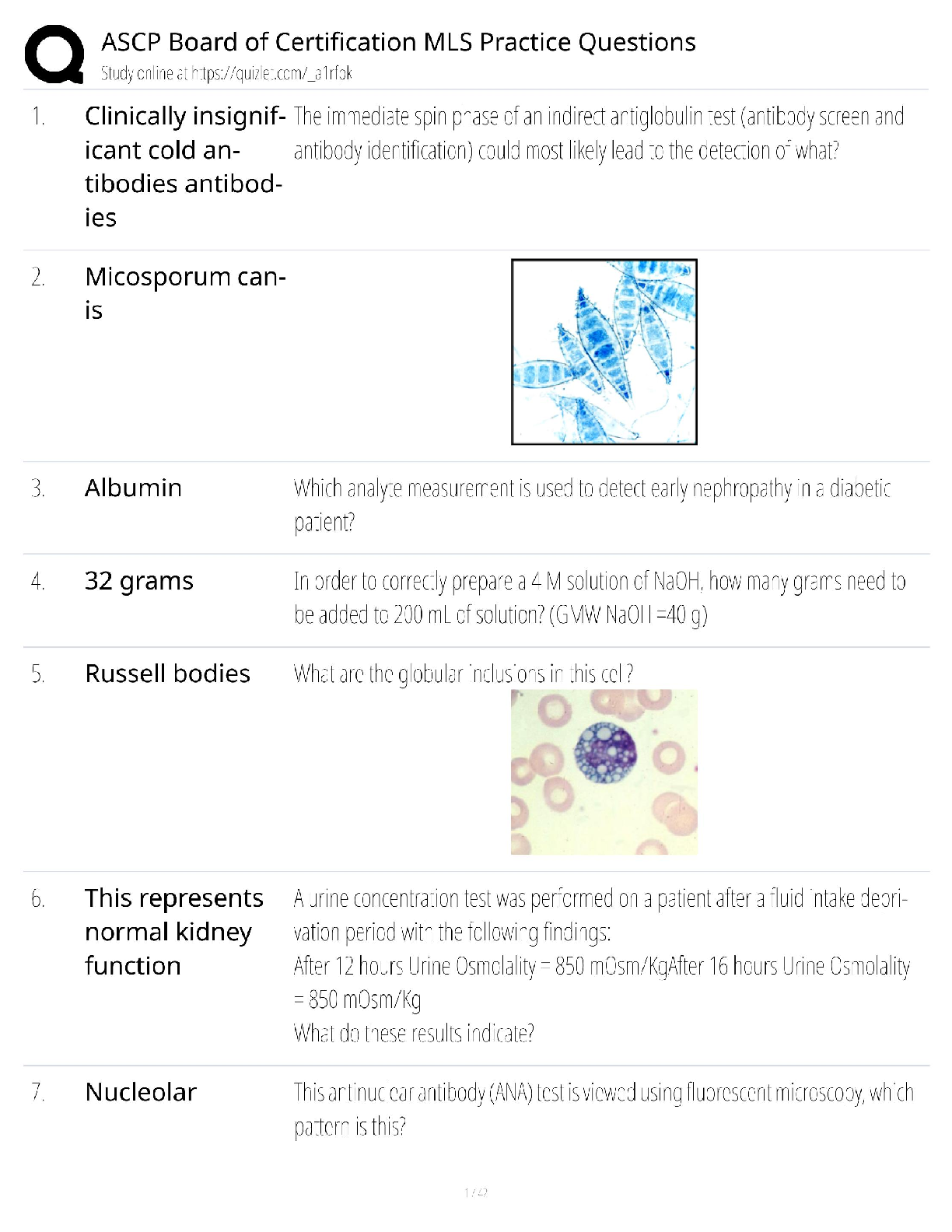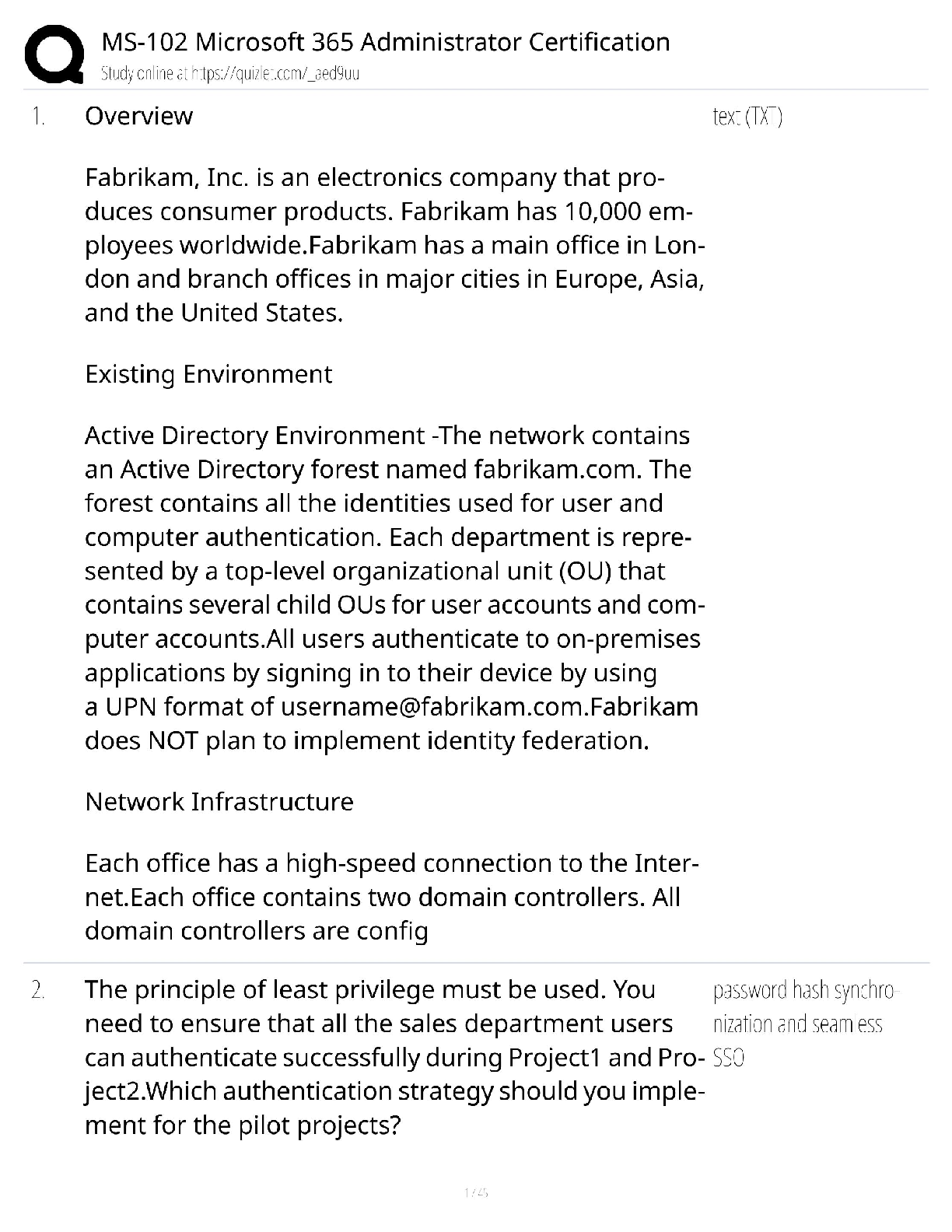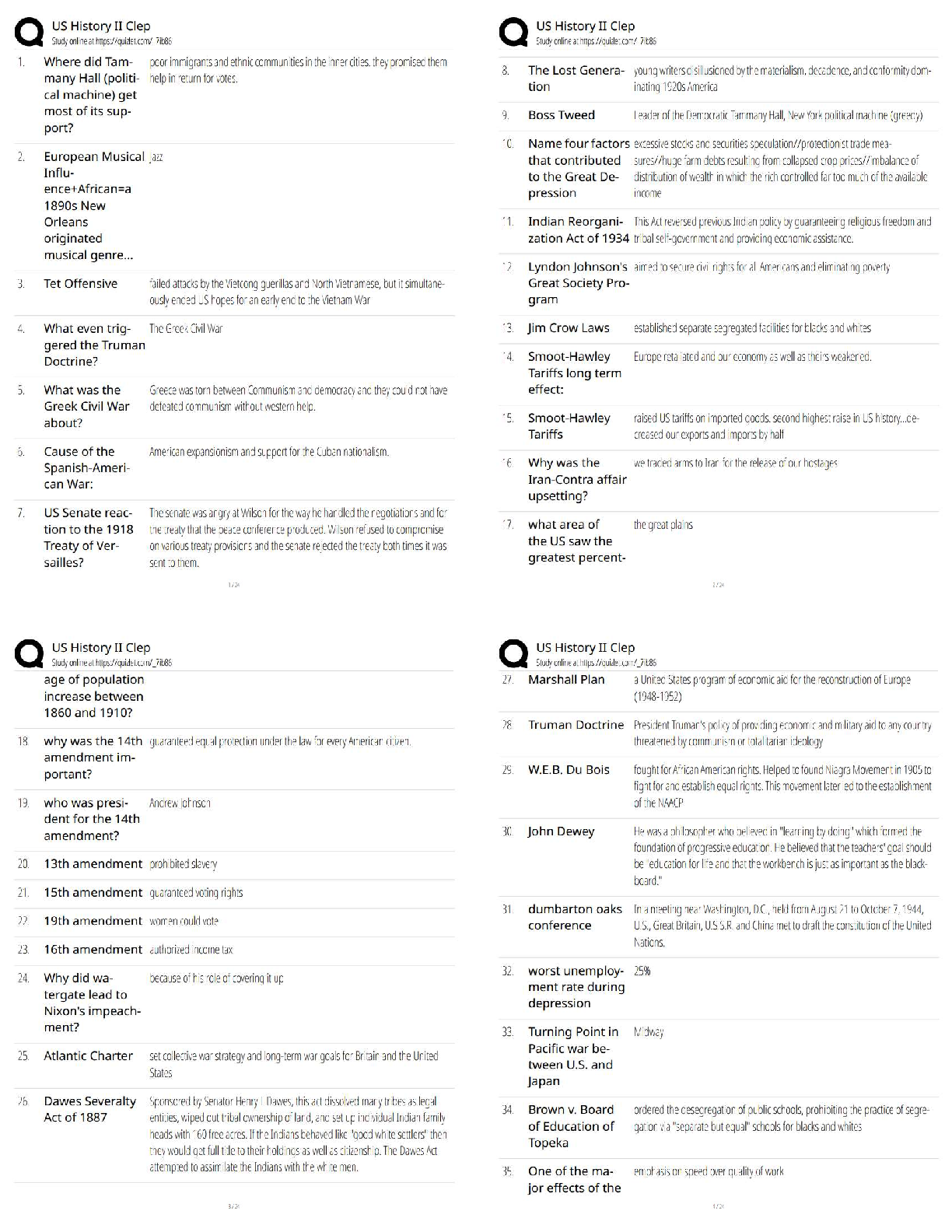MN 551 Unit 6 NCLEX Questions & Answers - Already Graded A, Kaplan University, Davenport.
Document Content and Description Below
MN 551 Unit 6 NCLEX Questions & Answers
Question 1. A 42-year-old female patient with a long-standing history of chronic nausea and vomiting but a near-insatiable appetite has had her symptoms at
...
tributed to an enzyme deficiency. Further diagnostic testing indicates that she has inadequate pancreatic enzyme levels and that her large appetite is due to a lack of enzyme control of food intake inhibition. In which of the following enzymes is the woman most likely deficient? (Points : 0.4)
Cholecystokinin
Ghrelin
Gastrin
Secretin
Question 2. A 20-year-old male college student has recently finished a Thanksgiving dinner of heroic proportions while home for the holiday weekend. Which of the following phenomena would most likely have produced his sensation of satiety? (Points : 0.4)
Stretch receptors in the stomach and small intestine signal the feeding center in the medulla.
Increased levels of leptin stimulate a decrease in appetite by way of the vagus nerve.
The breakdown of products of lipids such as ketoacids produces a decrease in appetite.
Cholecystokinin and glucagon-like peptide-1 suppress the hunger impulse.
Question 3. A 20-year-old male who is addicted to crystal methamphetamine has been admitted to the hospital with a diagnosis of protein-calorie malnutrition after many months of inadequate food intake. Which of the following treatment plans would the care team most likely favor? (Points : 0.4)
Intravenous infusion of albumin coupled with vitamin supplementation
Total parenteral nutrition
Incremental feeding combined with vitamin and mineral supplementation
Rapid administration of normal saline and carbohydrates
Question 4. Which of the following measures would likely be rejected as part of a first-line weight loss plan for a patient with a BMI of 30.2, type 2 diabetes, and hypertension? (Points : 0.4)
Prescription drug therapy
Gastric bypass
Calorie reduction by 500 to 1,000 kcal/day
30 minutes or more of moderate-intensity activity at least 3 days per week
Question 5. Chronic anxiety and stress contribute to ulcers. Which of the following effects of the sympathetic nervous system is most responsible for this effect? (Points : 0.4)
Inhibition of the actions of Brunner glands
Overstimulation of the oxyntic glands
Suppression of cholecystokinin
Inflammation of the parotid glands
Question 6. A nurse practitioner is providing care for a male patient with a long-standing hiatal hernia. Which of the following statements most accurately captures an aspect of the pathophysiology of hiatal hernias? (Points : 0.4)
Paraesophageal hiatal hernias are common and are normally not treated if the patient is asymptomatic.
The root causes of hiatal hernias are normally treatable with medication.
If esophageal acid clearance is impaired, esophagitis can result.
An incompetent pyloric sphincter and high fat diet are commonly implicated in the development of hiatal hernias.
Question 7. Cheryl has celiac disease. Which diet should you place her on? (Points : 0.4)
Low fat diet
Low residue diet
Gluten free diet
High protein diet
Question 8. A male patient complaining of chronic cramping, bloating, and diarrhea has been determined to have a deficiency in brush border enzymes within his small intestine. Which of the following meals or snacks is most likely to exacerbate the patient's signs and symptoms? (Points : 0.4)
Bran cereal and prunes
Tossed salad with an oil and vinegar dressing
Roast beef and a baked potato
Tortilla chips and guacamole
Question 9. As a result of oral ingestion of the microorganisms, an individual has contracted H. pylori. Which of the following health problems is the individual now at increased risk for? (Points : 0.4)
Inflammatory bowel disease (IBD)
Gastric adenocarcinoma
Gastric atrophy
Peptic ulcer
Esophagitis
Diverticular disease
Question 10. Which of the following patients is most clearly displaying the signs and symptoms of IBD? (Points : 0.4)
A 32-year-old mother who complains of intermittent abdominal pain that persists even after defecation.
A 51-year-old male who states that his stomach pain is in his lower abdomen, “comes and goes,” and “feels more like a cramp than a dull ache.”
A 44-year-old man who is under great financial stress and who states that his lower abdominal pain is much worse at night than during the day.
A 24-year-old man who has a stressful job but whose diarrhea and cramping do not worsen during periods of high stress.
Question 11. For several years, a 39-year-old female has been averaging two to three bottles of wine each night after her children go to sleep, and has included several ounces of brandy in recent years as well. Despite negative consequences to her career and the dissolution of her marriage, her drinking continued and now has culminated in a diagnosis of cirrhosis. Which of the following physical manifestations of the health problem would her care team anticipate? (Points : 0.4)
Ascites
Anorexia
Fever
Cognitive changes
Epigastric pain
Obesity
Question 12. Which of the following statements best captures an aspect of the process of fat digestion and absorption? (Points : 0.4)
Ingested triglycerides are broken down into absorbable form by gastric lipase.
Simple forms of fats are absorbed in the upper jejunum.
Long-chain fatty acids are absorbed more readily than medium-chain triglycerides.
Stool is not excreted until all fat is absorbed.
Question 13. A 51-year-old male professional is in the habit of consuming six to eight rum and cokes each evening after work. He assures the nurse practitioner, who is performing his regular physical exam, that his drinking is under control and does not have negative implications for his work or family life. How could the nurse best respond to the patient's statement? (Points : 0.4)
“You are more than likely inflicting damage on your liver, but this damage would cease as soon as you quit drinking.
“That may be the case, but you are still creating a high risk of hepatitis A or B or liver cancer.”
“In spite of that, the amount of alcohol you are drinking is likely to result first in cirrhosis and, if you continue, in hepatitis or fatty liver changes.”
“When your body has to regularly break down that much alcohol, your blood and the functional cells in your liver accumulate a lot of potentially damaging toxic byproducts.”
Question 14. A 43-year-old male patient has presented to the emergency department with vomiting that he claims is of sudden onset. The patient also states that the emesis has often contained frank blood in the hours prior to admission. Which of the following potential contributing factors would the care team first suspect?
(Points : 0.4)
Overuse of aspirin
Alcohol consumption
Staphylococcal enterotoxins
Effects of Helicobacter pylori
Question 15. A 48-year-old woman has been diagnosed with extrahepatic cholestasis
following a thorough history, ultrasound, and blood work. Which of the following symptoms most likely caused her to seek medical treatment, and what consequences of her health problem
would the medical team anticipate? (Points : 0.4)
Complaints of lower flank pain with consequences of impaired fat metabolism
Anorexia with consequences of impaired drug metabolism and blood filtration
Skin xanthomas (focal accumulations of cholesterol) with consequences of increased risk of bleeding due to deficient clotting factors
Pruritus with consequences of deficient levels of fat-soluble vitamins
Question 16. A 29-year-old female has been admitted to the emergency department following a suicide attempt by overdose of acetaminophen. What changes in the patient's liver and diagnostic results would the care team most likely anticipate? (Points : 0.4)
Centrilobular necrosis evidenced by increased ALT and AST levels
Allergic inflammation accompanied by an increase in serum IgE and basophils
Cholestatic reaction with increased bilirubin count
Rapid onset of hepatitis and increased GGT, ALT, and bilirubin levels
Question 17. A female neonate has been in respiratory distress since delivery and is unresponsive to oxygen therapy. Endoscopy has confirmed a diagnosis of esophageal atresia and tracheoesophageal fistula (EA/TEF). Which of the following explanations should the care team provide to the infant's parents? (Points : 0.4)
“We will have to perform surgery to correct the hole in her throat to make sure that she is able to swallow and breathe normally.”
“This problem will require respiratory therapy and supplementary feeding, but it will likely resolve itself over time.”
“The biggest risk that will face your daughter until this is fixed is the danger of malnutrition and dehydration.”
“The priority in our immediate treatment prior to her surgery will be pain management, as the contents of her stomach can burn her lungs.”
Question 18. A gastroenterologist is teaching a group of nurse practitioner students about the enteric nervous system in preparation for a consultation on a patient who has suffered a spinal cord injury. Which of the physician's teaching points is most accurate? (Points : 0.4)
“The myenteric plexus is responsible for controlling the function of each segment of the intestinal tract.”
“The enteric nervous system is made up of the myenteric and submucosal plexuses; these are located in the wall of the GI tract.”
“Sympathetic innervation of much of the GI tract occurs by way of the vagus nerve.”
“Parasympathetic stimulation blocks the release of the excitatory neuromediators and inhibits GI motility.”
Question 19. The mother of a 19-week-old infant has brought her baby to a nurse practitioner for assessment because of the baby's persistent weight loss and diarrhea. An intestinal biopsy has confirmed a diagnosis of celiac disease, and the child's mother is anxious to know what caused the disease. Which of the following aspects of the etiology of celiac disease would underlie the explanation that the nurse practitioner provides? (Points : 0.4)
Bacterial or chemical invasion of the peritoneum leads to decreased nutrient absorption and transport.
An inappropriate T-cell mediated response results in increased levels of antibodies and an inflammatory response.
Neurogenic or muscular inhibition of peristalsis results in inappropriate motility of ingested food in the lower small intestine and the colon.
Inability to process or absorb the fat content of breast milk results in malnutrition and deficiency of fat-soluble vitamins.
Question 20. A 24-year-old woman undergoing a premarital screening test is found to have elevated levels of AST, ALT, and IgG, but no antibody-specific markers for viral hepatitis. A liver biopsy reveals inflammation and cellular damage. Which of the following treatments is most likely to be
effective for her? (Points : 0.4)
Lamivudine
Peginterferon and ribavirin
Interferon-alfa-2b
Corticosteroids and immunosuppressant drugs
Question 21. After several months of persistent heartburn, a 57-year-old female patient has been diagnosed with gastroesophageal reflux disease (GERD). Which of the following treatment regimens is likely to best address the woman's health problem? (Points : 0.4)
Surgical correction of the incompetent pylorus
Antacids, avoiding positions that exacerbate reflux, and a soft-textured diet
Weight loss and administration of calcium channel blocking medications
Proton pump inhibitors, avoiding large meals, and remaining upright after meals
Question 22. A 43-year-old male who is 5 feet 10 inches tall and weighs 216 pounds has been informed by his nurse practitioner that his body mass index (BMI) is 31. Which of the following clinical conclusions based on these data would his nurse be most justified in rejecting? (Points : 0.4)
Further investigation of his nutritional status is needed to supplement the BMI value.
The patient faces an increased risk of type 2 diabetes and hyperlipidemia.
He is classified as being obese, likely as the result of the interplay of genetic and lifestyle factors.
The patient is borderline obese but is not yet at the point of significantly increased risks to health.
Question 23. David has an acute exacerbation of Crohn’s disease. Which of the following lab tests would you expect to be decreased? (Points : 0.4)
Sedimenatation rate
Liver enzyme levels
Vitamins A, B complex and C levels
Bilirubin level
Question 24. A 40-year-old female has been categorized as being obese, with a BMI of 33.2. Which of the following health problems is the patient at a significantly increased risk for compared with individuals with a BMI below 25? (Points : 0.4)
Cardiac arrhythmias
Osteoarthritis
Multiple sclerosis
Atelectasis
Gallbladder disease
Insulin resistance
Question 25. Which of the following patients on a hospital medical unit is most clearly demonstrating the signs and symptoms of liver failure?(Points : 0.4)
A 44-year-old man with low hemoglobin levels, low platelet levels, and spider angiomas
A 50-year-old woman with blood pressure of 189/103, jaundice, and multiple thrombosis
A 68-year-old female patient with sudden onset of confusion, a history of alcohol abuse, and low levels of serum AST and ALT
A 55-year-old man with ascites, fever, and recent onset of atrial fibrillation
Question 26. A 43-year-old male patient has presented to the emergency department with vomiting that he claims is of sudden onset. The patient also states that the emesis has often contained frank blood in the hours prior to admission. Which of the following potential contributing factors would the care team first suspect?
Question 27. A 55-year-old man has been diagnosed with a hiatal hernia, in which the function of the lower esophageal sphincter is compromised. Which of the following consequences of this condition is most likely?
Question 28. A 71-year-old male has been recently diagnosed with a stage III tumor of colorectal cancer and is attempting to increase his knowledge about his diagnosis. Which of the following statements about colorectal cancer demonstrates a sound understanding of the disease?
Question 29. A 79-year-old male resident of a long-term care facility has contracted Clostridium difficile and is experiencing consequent diarrhea. Auscultation of the man's abdomen indicates hyperactive bowel sounds. What processes in the man's small intestine are most likely accompanying his current status?
Question 30. As part of the intake protocol at an eating disorders clinic, an interview precedes a physical examination. Which of the following s would a clinician be justified in excluding from an intake interview for a 16-year-old female referred by her pediatrician for the treatment of anorexia nervosa?
Question 31. While on tour, a 32-year-old male musician has presented to the emergency department of a hospital after a concert complaining of severe and sudden abdominal pain. He admits to a history of copious alcohol use in recent years, and his vital signs include a temperature of 38.8°C (101.8°F), blood pressure of 89/48 mm Hg, and heart rate of 116 beats per minute. Blood work indicates that his serum levels of C-reactive protein, amylase, and lipase are all elevated. Which of the following diagnoses would the care team first suspect?
[Show More]
Last updated: 3 years ago
Preview 1 out of 11 pages
